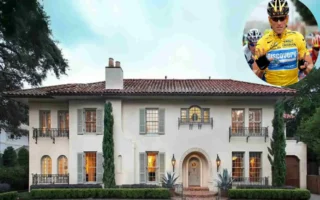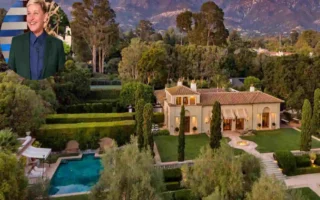If you’re a fan of Hollywood history, architecture, or cultural travel, the Shirley Temple House is a fascinating destination to explore. This iconic estate offers a unique glimpse into the life of one of Hollywood’s most beloved child stars and her family’s efforts to create a private sanctuary amid the whirlwind of fame.
History of the Shirley Temple House
The Legacy of Shirley Temple
| Personal Info | Details |
|---|---|
| Full Name | Shirley Jane Temple |
| Married Name | Shirley Temple Black |
| Date of Birth | April 23, 1928 |
| Place of Birth | Santa Monica, California, United States |
| Date of Death | February 10, 2014 |
| Place of Death | Woodside, California, United States |
| Age at Death | 85 |
| Parents | Gertrude Temple (homemaker), George Temple (bank employee) |
| Ethnicity | Dutch, English, and German ancestry |
| Career Highlights | Child Actress, Singer, Dancer, Author, Diplomat |
| Notable Acting Period | 1931 (age 3) – 1949 (final film) |
| Political/Diplomatic Roles | U.S. Ambassador to Ghana and Czechoslovakia, Chief of Protocol U.S. |
| Marriages | John Agar (1945–1950), Charles Alden Black (1950–2005) |
| Children | 3 (Linda Susan Agar, Charles Alden Black Jr., Lori Black) |
| Awards | Juvenile Academy Award (1935), Kennedy Center Honors (1998), Screen Actors Guild Life Achievement Award |
| Net Worth & Real Estate | Details |
|---|---|
| Net Worth at Death | Approximately $30 million |
| Notable Assets | Home in Woodside, California (worth about $5 million at her death) |
| Unique Possession | 9.54-carat blue diamond gifted in 1940s |
| Residence at Time of Death | Details |
|---|---|
| Last Known Residence | Woodside, California, USA |
| Home Worth | Approximately $5 million |
Shirley Temple was not just a child star; she was a cultural phenomenon. Born in 1928, she rose to fame in the 1930s with her charming performances, curly hair, and infectious smile. Her movies brought joy during the Great Depression, making her one of the most famous child actresses in history. Beyond Hollywood, Shirley Temple had a remarkable career in diplomacy, serving as a U.S. ambassador and delegate to the United Nations later in life. Her legacy is a blend of entertainment and public service, making her story truly inspiring.
Origins and Construction
As Shirley’s fame skyrocketed, her family sought a peaceful retreat away from the public eye. They chose Brentwood Park in Los Angeles, a neighborhood known for its privacy and natural beauty. The estate spans over 3 acres, stretching from Rockingham Avenue to Sunset Boulevard, providing ample space to meet the family’s needs and maintain privacy.
The decision to build a custom home was driven by the desire to create a safe and comfortable environment where Shirley could enjoy a normal childhood, despite her extraordinary career. This move marked a new chapter for the family, blending Hollywood glamour with suburban tranquility.
Notable Architects Involved
The Shirley Temple House was designed by two prominent architects: John Byers and Edla Muir. Both were known for their mastery of the Spanish Colonial Revival style, which was popular in Southern California during the early 20th century. Their vision combined elegance with functionality, creating a home that was both beautiful and livable. The architects paid close attention to detail, ensuring the house reflected the family’s personality and lifestyle.
Architectural Highlights of Shirley Temple House
| Attribute | Details |
|---|---|
| Shirley-Eustis House | |
| 33 Shirley Street, Boston, Massachusetts | |
| 1746–1749 | |
| High-style Georgian architecture, with later Federal-style renovations | |
| Peter Harrison, first colonial American architect | |
| Originally a summer estate and single-family residence for Massachusetts Governor William Shirley; now a historic house museum | |
| Approximately 75 feet wide by 50 feet deep; two stories plus full-height basement | |
| Double-hip, double-boarded roof with wood shingles (lower slope) and standing-seam copper (upper slope); central hexagonal wood cupola | |
| Wood clapboards façade, 10 full-height pilasters with Doric capitals, dentiled wood cornice, quoined wood blocks around main door, wood shutters on windows | |
| Rectangular center-hall, double-pile plan; four rooms on each side of central hall; mix of Georgian and Federal finishes | |
| Built for Colonial Governor William Shirley; later owned by Governor William Eustis and widow Caroline Langdon Eustis; among oldest remaining colonial governor mansions in the original Thirteen Colonies; restored and maintained by the Shirley-Eustis House Association | |
| Historic house museum and community open space with landscaped gardens | |
| Reoriented around 1868, converted temporarily into apartments, underwent Federal-style renovations, piazzas added and removed, roof and window changes | |
| Includes a mid-18th century timber-frame outbuilding (likely barn), converted later to duplex rental housing | |
| Rough-cut granite and Roxbury puddingstone ashlar blocks for basement; wood clapboards and flush board siding for walls | |
| Value not explicitly stated in sources, but recognized as a National Historic Landmark and significant cultural asset, which places high heritage value on property |
Exterior Design and Curb Appeal
The house’s exterior is a stunning example of Spanish Colonial Revival architecture. It features classic red-tiled roofs, white stucco walls, and wrought-iron accents that give it timeless charm. Spanning over 5,000 square feet, the home boasts an impressive facade that immediately captures attention.
You may also read (cecil b demille house).
The sprawling gardens surrounding the house enhance its curb appeal, featuring lush greenery and carefully designed landscaping that add to its privacy and beauty. The estate’s size and design make it a standout property in Brentwood Park.
Interior Layout and Unique Features
Inside, the house is just as captivating. Key rooms include spacious living areas perfect for family gatherings, Shirley’s childhood bedroom filled with memorabilia, and special entertainment spaces designed for fun and relaxation.
The interiors are decorated with historical furnishings and personal items, including gifts from fans and Hollywood peers. These touches create a warm, nostalgic atmosphere that invites visitors to step back in time and experience the home as Shirley and her family did.
The Magical Backyard and Playhouse
One of the most enchanting parts of the estate is Shirley’s famous playhouse. This miniature cottage, complete with electricity, was a beloved childhood retreat where Shirley could play and imagine away from the spotlight.
The backyard also features a pool area and beautifully maintained gardens, all designed to offer privacy and leisure. These outdoor spaces helped nurture Shirley’s “ordinary” upbringing despite her extraordinary fame, providing a haven for family fun and relaxation.
Life Inside the Shirley Temple House
Day-to-Day Family Life
Despite Shirley’s celebrity status, her mother worked hard to maintain a grounded and structured childhood. The family followed routines that included regular meal times, lessons, and rest periods, all within the comfort of their home.
This balance between normal family life and public attention was crucial in helping Shirley grow up with a sense of stability and security, even as her fame grew exponentially.
Social Events and Hollywood Connections
The Shirley Temple House was not only a private retreat but also a hub of Hollywood social life. The family hosted gatherings and parties attended by celebrities and industry insiders, making the home a lively place filled with laughter and camaraderie.
Shirley’s childhood celebrations often attracted media coverage, highlighting the blend of family warmth and star-studded glamour that defined the estate.
Security and Privacy
Given Shirley’s popularity, the family took extensive measures to protect their privacy. The estate is surrounded by tall hedges, secure gates, and carefully planned landscaping designed to shield the home from fans and paparazzi.
These security features allowed the family to enjoy their home life without constant intrusion, preserving the sanctuary they had worked so hard to create.
The Shirley Temple House Over the Years
Changes in Ownership
The Temple family lived in the house for many years, cherishing it as their private haven. Over time, ownership changed hands, with later owners either preserving the original charm or making modifications to suit modern needs.
You may also read (inside kyrie irvings luxurious home a sneak peek).
Despite these changes, the house’s core character and historical significance have remained intact, continuing to attract attention from admirers and historians alike.
Renovations and Restorations
To preserve the home’s legacy, renovations have been carefully planned to strike a balance between historic preservation and modern comforts. Updates have included structural repairs, interior refurbishments, and landscape enhancements, all of which have been executed with respect for the original design.
These efforts ensure that the Shirley Temple House remains a beautiful and functional residence while honoring its past.
Public Interest and Cultural Impact
The house has become a point of interest for historians, architecture enthusiasts, and fans of Shirley Temple. It has been featured in architectural magazines and media outlets, highlighting its cultural and historical importance.
Visitors and scholars alike appreciate the home as a symbol of Hollywood’s golden era and a testament to the family’s dedication to privacy and style.
Visiting Shirley Temple House Today
Location and Getting There
The Shirley Temple House is located in the prestigious Brentwood Park neighborhood of Los Angeles. This area is known for its beautiful homes, quiet streets, and proximity to major LA landmarks.
Visitors can reach the estate by car or public transportation, with several options available depending on their location of origin. Parking and traffic tips can make your visit run more smoothly.
How to Arrange a Visit
Currently, the Shirley Temple House is a private residence and is not regularly open to the public for tours. However, some local tour operators may include the exterior of the home as part of celebrity home tours in the area.
If you plan to visit, it’s best to check for any open house events or special guided tours that might be available. Always respect the privacy of current residents and avoid trespassing on private property.
Nearby Attractions
Brentwood and the surrounding Los Angeles area offer many other attractions worth visiting. From other Hollywood celebrity homes to architectural landmarks and cultural sites, you can easily plan a full day exploring the rich history and beauty of the region.
Some nearby highlights include the Getty Center, the Hollywood Walk of Fame, and Grauman’s Chinese Theatre, all perfect complements to your visit to the Shirley Temple House.
Insider Tips for the Ultimate Visitor Experience
Best Photo Opportunities
While the Shirley Temple House itself is private, there are public vantage points where you can capture beautiful photos of the exterior and gardens. Early morning or late afternoon light often provides the best conditions for photography.
Remember to be respectful: avoid entering private property or disturbing residents when taking pictures.
Remembering Shirley Temple’s Legacy
To deepen your appreciation of Shirley Temple’s life and career, consider visiting local museums or exhibits that feature her memorabilia. These places offer a richer context for understanding her impact on Hollywood and beyond.
Extending your trip to include iconic Hollywood sites, such as the Walk of Fame or the Chinese Theatre, can also enhance your experience and connection to the era.
Where Does Shirley Temple Currently Live?
Shirley Temple passed away on 10 February 2014, at her home in Woodside, California. Therefore, she does not currently live anywhere.
You may also read (inside the luxurious life of gabriel swaggarts mansion).






